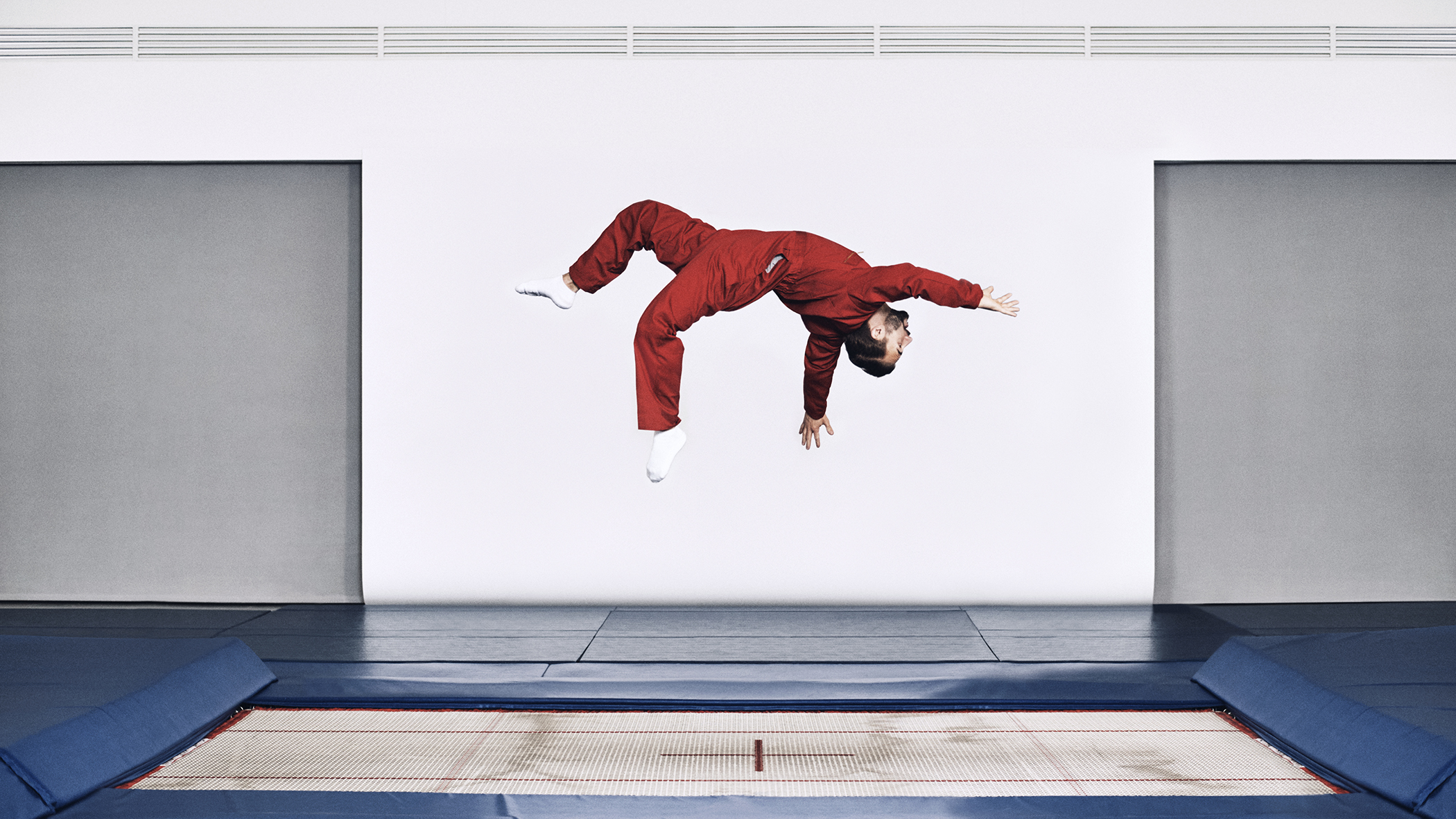How to fall to your death and live to tell the tale
From slips in the shower to stumbles down the stairs, falls kill more than 32,000 Americans every year. Doctors say learning how to take a spill might just save your life.

Alcides Moreno and his brother Edgar were window washers in New York City. The two Ecuadoran immigrants worked for City Wide Window Cleaning, suspended high above the congested streets, dragging wet squeegees across the acres of glass that make up the skyline of Manhattan.
On Dec. 7, 2007, the brothers took an elevator to the roof of Solow Tower, a 47-story apartment building on the Upper East Side. They stepped onto the 16-foot-long, 3-foot-wide aluminum scaffolding designed to slowly lower them down the black glass of the building.
But the anchors holding the 1,250-pound platform gave way, plunging them 472 feet to the alley below. The fall lasted six seconds. Edgar, at 30 the younger brother, tumbled off the scaffolding, hit the top of a wooden fence, and was killed instantly.
The Week
Escape your echo chamber. Get the facts behind the news, plus analysis from multiple perspectives.

Sign up for The Week's Free Newsletters
From our morning news briefing to a weekly Good News Newsletter, get the best of The Week delivered directly to your inbox.
From our morning news briefing to a weekly Good News Newsletter, get the best of The Week delivered directly to your inbox.
But rescuers found Alcides alive, sitting up amid the wreckage, breathing and conscious.
Falls are one of life's great overlooked perils. We fear terror attacks, shark bites, Ebola outbreaks, and other minutely remote dangers, yet more than 420,000 people die worldwide each year after falling. Falls are the second-leading cause of death by injury, after car accidents. In the United States, falls cause 32,000 fatalities a year (more than four times the number caused by drowning and fires combined). Nearly three times as many people die in the U.S. after falling as are murdered by firearms.
Falls are even more significant as a cause of injury. More patients go to emergency rooms in the U.S. after falling than from any other form of mishap, according to the Centers for Disease Control and Prevention (CDC), nearly triple the number injured by car accidents. The cost is enormous. As well as taking up more than a third of ER budgets, fall-related injuries often lead to expensive personal injury claims.
It makes sense that falls dwarf most other hazards. To be shot or get in a car accident, you first need to be in the vicinity of a gun or a car. But falls can happen anywhere at any time to anyone.
A free daily email with the biggest news stories of the day – and the best features from TheWeek.com
Spectacular falls from great heights outdoors, like the plunge of the Moreno brothers, are extremely rare. The most dangerous spots for falls are not rooftops or cliffs, but the low-level, interior settings of everyday life: shower stalls, supermarket aisles, and stairways. Any fall, even a tumble out of bed, can change life profoundly, taking someone from robust health to grave disability in less than one second.
Scientists are now encouraging people to learn how to fall to minimize injury — to view falling not so much as an unexpected hazard to be avoided as an inevitability to be prepared for. Training may even have been a factor determining the outcome of the Moreno brothers' fall to earth nearly 10 years ago.
Doctors at New York–Presbyterian hospital did not want to risk moving Alcides Moreno from the emergency room for fear that the slightest additional bump might kill him. They started surgery in the ER. He had two broken legs, a broken arm, a broken foot, several broken ribs, and a crushed vertebra that could have paralyzed him, as well as two collapsed lungs, a swollen brain, plus several other ruptured organs. Alcides was given 24 pints of blood and 19 pints of plasma before the bleeding could be stopped.
Doctors marveled that he was alive at all, reaching for an explanation not often used in medical literature: "miracle."
"It's not the fall that gets you," the skydiving joke goes. "It's the sudden stop at the bottom." Deceleration is the key to surviving falls and reducing injuries. It isn't the length of the fall that's relevant, but what happens as you reach the ground.
One theory was that Alcides lived because, when the scaffolding gave way, he lay flat and clung to the platform, as professional window washers are trained to do. The scaffold fell not in the open street but in a narrow alley — air resistance may have built up against the platform, slowing it. The platform also may have scraped against the building and its neighbor, reducing its rate of fall. The aluminum crushed on impact, and landed on a pile of cables, and both absorbed some of the impact, forming a cushioned barrier.
You can trip or slip when walking, but someone standing still can fall, too — because of a loss of consciousness, vertigo, or, as the Moreno brothers remind us, something supposedly solid giving way. However it happens, gravity takes hold and a brief, violent drama begins. And like any drama, every fall has a beginning, a middle, and an end.
"We can think of falls as having three stages: initiation, descent, and impact," says Stephen Robinovitch, a professor in the School of Engineering Science and the Department of Biomedical Physiology and Kinesiology at Simon Fraser University in British Columbia, Canada. "Most research in the area of falls relates to 'balance maintenance' — how we perform activities such as standing, walking, and transferring without losing balance."
By "transferring," he means changing from one state to another: from walking to stopping, from lying in a bed to standing, or from standing to sitting in a chair. "We have found that falls among older adults in long-term care are just as likely to occur during standing and transferring as during walking," says Robinovitch, who installed cameras in a pair of Canadian nursing homes and closely analyzed 227 falls over three years.
Only 3 percent were due to slips and 21 percent due to trips, compared with 41 percent caused by incorrect weight shifting — excessive sway during standing, or missteps during walking.
Elderly people are particularly prone to falls because they are more likely to have illnesses that affect their cognition, coordination, agility, and strength. "Almost anything that goes wrong with your brain or your muscles or joints is going to affect your balance," says Fay Horak, professor of neurology at Oregon Health & Science University.
Fall injuries are the leading cause of death by injury in people over 60, says Horak. Every year, about 30 percent of those 65 and older living in senior residences have a fall, and when they get older than 80, that number rises to 50 percent. A third of those falls lead to injury, according to the CDC, with 5 percent resulting in serious injury. It gets expensive. In 2012, the average hospitalization cost after a fall was $34,000.
How you prepare for the possibility of falling, what you do when falling, what you hit after falling — all determine whether and how severely you are hurt. And what condition you are in is key. A Yale School of Medicine study of 754 over-70s, published in the Journal of the American Medical Association in 2013, found that the more serious a disability you have beforehand, the more likely you will be severely hurt by a fall. Even what you eat is a factor: A study of 6,000 elderly French people in 2015 found a connection between poor nutrition, falling, and being hurt in falls.
Christine Bowers is 18. She hails from upstate New York and is a student at the Moody Bible Institute in Chicago. One day she hopes to teach English abroad. In January 2016 she had a cavernous malformation — a tangle of blood vessels deep within her brain — removed.
"It paralyzed my left side," she says, as her physical therapist straps her into a complex harness in a large room filled with equipment at the Shirley Ryan AbilityLab. "I'm working on preventing a fall."
Under the supervision of therapist Ashley Bobich, Bowers is walking on the KineAssist MX, a computerized treadmill with a robotic arm and harness device at the back. The metal arm allows patients freedom of motion but catches them if they fall. This version of the device is quite new. The AbilityLab only got it at the end of 2016, and Bowers is the second patient of Bobich's to try it. Previously, those in danger of falling would be tethered to overhead gate tracks, a far cruder system.
Being a student, Bowers often finds herself in crowded academic hallways, and she says she values her cane as much for alerting those around her that she has mobility problems as for support. Seeing the cane, she says, her classmates tend to give her a bit of room as they hurry through the corridors.
Still, she has fallen several times, and those falls made her very skittish about walking, a serious problem in the rehabilitation of those who have fallen. "It's huge," says Bobich. "Fear of falling puts you at risk for falling."
Elliot Roth agrees. "Falls often cause fear of falling, and fear of falling often causes fear of walking, and fear of walking often causes abnormal or inadequate walking," he says. A challenge of rehabilitation is to not only increase physical capacity but also build patient confidence.
"We've been doing what's called 'perturbation training,' where I pick a change in the treadmill speed," says Bobich. "She's walking along, I hit the button, and the treadmill speeds up on her and she has to react. ... Her biggest fear was slipping on ice, so I said, 'You know what? I have a really great way for us to train for that.'"
The treadmill hums while Bobich speeds it up and slows it down, and Bowers, her right hand clasping her paralyzed left, struggles to maintain her balance.
"You're getting better at this," says Bobich. "You're getting way better."
The KineAssist is an example of how technology that was once used to study ailments is now used to help patients. Advanced brain scanning, having identified the regions responsible for balance, now diagnoses damage that affects them. Accelerometers attached to people's ankles and wrists have been used in experiments, plotting induced falls directly into a computer for study, and are now being used to diagnose balance problems — or to detect when someone living alone has fallen and summon help.
Is there anything you can do to lessen harm in the split second after you start to fall? Scientists studying falling are developing "safe landing responses" to help limit the damage from falls. If you are falling, first protect your head: 37 percent of falls by elderly people in a study by Robinovitch and colleagues involved hitting their heads, particularly during falls forward. Fight trainers and parachute-jump coaches encourage people to try not to fall straight forward or backward. The key is to roll, and to try to let the fleshy side parts of your body absorb the impact.
"You want to reach back for the floor with your hands," says Chuck Coyle, fight director at the Lyric Opera of Chicago, describing how he tells actors to fall on stage. "Distribute the weight on the calf, thigh, into the glutes, rolling on the outside of your leg as opposed to falling straight back."
Young people break their wrists because they shoot their hands out quickly when falling. Older people break their hips because they don't get their hands out quickly enough. You'd much rather break a wrist than a hip.
Alcides Moreno underwent 15 more surgeries and was in a coma for weeks. He then underwent a long regimen of physical and occupational therapy at the Kessler Institute for Rehabilitation in New Jersey, working to strengthen his legs, restore his balance, and walk. Occupational therapy was necessary, as well as counseling, as he had grown depressed over the loss of his brother Edgar.
He is unable to return to work but received a multimillion-dollar settlement in his lawsuit against the scaffolding company, Tractel, after a Manhattan court found that it had installed the platform negligently. The sum wasn't revealed, but a source said it was more than the $2.5 million that Edgar's family received.
Alcides and his family moved to Arizona and live outside Phoenix. He keeps busy, driving his kids to school and to sporting events, and likes to work out in the gym.
Last year he and his wife had a fourth child, a son.
"I keep asking myself why I lived," he told the BBC this year. "I have a new baby — he must be the reason, to raise this kid and tell him my history."
Excerpted from an article that was first published by the Wellcome Trust at Mosaic Science. Republished under a Creative Commons license.
-
 Why the world is going mad about Taylor Swift's wedding
Why the world is going mad about Taylor Swift's weddingThe pop star unveiled diamond ring in cosy snaps with fiancé Travis Kelce earlier this week
-
 Hostage: Netflix's 'fun, fast and brash potboiler'
Hostage: Netflix's 'fun, fast and brash potboiler'The Week Recommends Suranne Jones is 'relentlessly defiant' as prime minister Abigail Dalton
-
 France political crisis: what does Bayrou's gamble mean for Macron?
France political crisis: what does Bayrou's gamble mean for Macron?The French president could see his authority damaged beyond repair should another of his governments fail